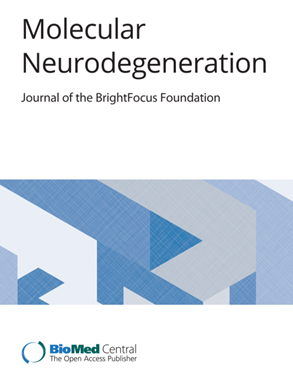Increased expression of mesencephalic astrocyte-derived neurotrophic factor (MANF) contributes to synapse loss in Alzheimer’s disease
IF 14.9
1区 医学
Q1 NEUROSCIENCES
引用次数: 0
Abstract
The activation of endoplasmic reticulum (ER) stress is an early pathological hallmark of Alzheimer’s disease (AD) brain, but how ER stress contributes to the onset and development of AD remains poorly characterized. Mesencephalic astrocyte-derived neurotrophic factor (MANF) is a non-canonical neurotrophic factor and an ER stress inducible protein. Previous studies reported that MANF is increased in the brains of both pre-symptomatic and symptomatic AD patients, but the consequence of the early rise in MANF protein is unknown. We examined the expression of MANF in the brain of AD mouse models at different pathological stages. Through behavioral, electrophysiological, and neuropathological analyses, we assessed the level of synaptic dysfunctions in the MANF transgenic mouse model which overexpresses MANF in the brain and in wild type (WT) mice with MANF overexpression in the hippocampus. Using proteomic and transcriptomic screening, we identified and validated the molecular mechanism underlying the effects of MANF on synaptic function. We found that increased expression of MANF correlates with synapse loss in the hippocampus of AD mice. The ectopic expression of MANF in mice via transgenic or viral approaches causes synapse loss and defects in learning and memory. We also identified that MANF interacts with ELAV like RNA-binding protein 2 (ELAVL2) and affects its binding to RNA transcripts that are involved in synaptic functions. Increasing or decreasing MANF expression in the hippocampus of AD mice exacerbates or ameliorates the behavioral deficits and synaptic pathology, respectively. Our study established MANF as a mechanistic link between ER stress and synapse loss in AD and hinted at MANF as a therapeutic target in AD treatment.间脑星形胶质细胞源性神经营养因子(MANF)的表达增加是阿尔茨海默病突触丢失的原因之一
内质网(ER)应激的激活是阿尔茨海默病(AD)大脑的早期病理特征,但ER应激是如何导致阿尔茨海默病发病和发展的,目前还没有明确的定论。间脑星形胶质细胞源性神经营养因子(MANF)是一种非典型神经营养因子,也是一种ER应激诱导蛋白。先前的研究报告称,MANF在有症状前和有症状的AD患者大脑中均有所增加,但MANF蛋白早期升高的后果尚不清楚。我们研究了不同病理阶段AD小鼠模型脑中MANF的表达。通过行为学、电生理学和神经病理学分析,我们评估了在大脑中过表达MANF的MANF转基因小鼠模型和在海马中过表达MANF的野生型(WT)小鼠的突触功能障碍水平。通过蛋白质组和转录组筛选,我们确定并验证了MANF影响突触功能的分子机制。我们发现,MANF表达的增加与AD小鼠海马中突触的丧失相关。通过转基因或病毒方法在小鼠体内异位表达MANF会导致突触缺失以及学习和记忆缺陷。我们还发现,MANF与ELAV类RNA结合蛋白2(ELAVL2)相互作用,并影响其与参与突触功能的RNA转录本的结合。增加或减少MANF在AD小鼠海马中的表达可分别加剧或改善行为缺陷和突触病理学。我们的研究确定了MANF是ER应激与AD突触丧失之间的机理联系,并暗示MANF是AD治疗的靶点。
本文章由计算机程序翻译,如有差异,请以英文原文为准。
求助全文
约1分钟内获得全文
求助全文
来源期刊

Molecular Neurodegeneration
医学-神经科学
CiteScore
23.00
自引率
4.60%
发文量
78
审稿时长
6-12 weeks
期刊介绍:
Molecular Neurodegeneration, an open-access, peer-reviewed journal, comprehensively covers neurodegeneration research at the molecular and cellular levels.
Neurodegenerative diseases, such as Alzheimer's, Parkinson's, Huntington's, and prion diseases, fall under its purview. These disorders, often linked to advanced aging and characterized by varying degrees of dementia, pose a significant public health concern with the growing aging population. Recent strides in understanding the molecular and cellular mechanisms of these neurodegenerative disorders offer valuable insights into their pathogenesis.
 求助内容:
求助内容: 应助结果提醒方式:
应助结果提醒方式:


